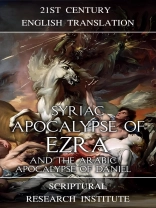The Syriac Apocalypse of Ezra is a separate apocalypse of Ezra, also sometimes called the Revelation of Ezra. Like the Catholic Apocalypse of Ezra, it appears to have been reworked in the High Middle Ages. Another version of the apocalypse has survived in Arabic, but is attributed to Daniel not Ezra, commonly known as the Arabic Apocalypse of Daniel. The Arabic version is shorter and appears to be older, likely dating to earlier than the time of Muhammad, while the Syriac version has been reworked into an anti-Islamic apocalypse, likely between 1229 and 1244. The apocalypse includes a reference from the High Middle Ages to Muslims as Ishmaelites, and Mongols as Gog and Magog, forming an alliance and conquering Jerusalem. This idea would not have been conceivable until the Mongols defeated the Khwarazmian Empire, an Islamic Turko-Persian empire in Iran and Central Asia. Before that, the idea that the Mongols could reach Jerusalem was not a consideration.
The Apocalypse indicates that the city of Jerusalem was occupied by Christians at the time, which would place the anti-Islamic redaction sometime between 1229 and 1244. The Latin crusaders had been driven out of Jerusalem in 1187, however, the kingdom of Jerusalem continued to exist, first from its capital in Tyre, and later Acre, however, in 1229 Jerusalem was recaptured, and held until 1244. As the Principality of Antioch was another crusader state to the north, and the name ‘Antioch’ appears to have been added earlier in the Apocalypse, the redactor may have meant it as a piece of propaganda intended to garner support from Byzantine Christians, who had not generally participated in the crusades and had better relations with the Muslims than the Catholics.
The older Arabic version of the apocalypse likewise appears to have been used for propaganda, however, was anti-Jewish instead of anti-Islamic, and appears to have been translated into Arabic before the time of Muhammad. Based on the dialect of Arabic, it most likely originated in Palestine among early Christians. The Arabic version is much shorter and is mostly paraphrased from the Gospels and other early Christian works, however, the content of the apocalypse is clearly something that was incorporated into the longer Syriac Apocalypse. While the content of the Arabic apocalypse is repeated in the Syriac apocalypse, it is not a direct translation, but a series of paraphrases that are reinterpreted in an anti-Islamic way. Nevertheless, while the longer Syriac apocalypse must originate much later than the pre-Islamic Arabic apocalypse, it has much more content, most of which appears to have been composed in Neo-Babylonian sometime between 597 and 592 BC.
Scriptural Research Institute
Syriac Apocalypse of Ezra and the Arabic Apocalypse of Daniel [EPUB ebook]
Syriac Apocalypse of Ezra and the Arabic Apocalypse of Daniel [EPUB ebook]
Compre este e-book e ganhe mais 1 GRÁTIS!
Língua Inglês ● Formato EPUB ● ISBN 9781739069162 ● Tamanho do arquivo 3.5 MB ● Editora Digital Ink Productions ● Publicado 2025 ● Carregável 24 meses ● Moeda EUR ● ID 9246024 ● Proteção contra cópia Adobe DRM
Requer um leitor de ebook capaz de DRM












